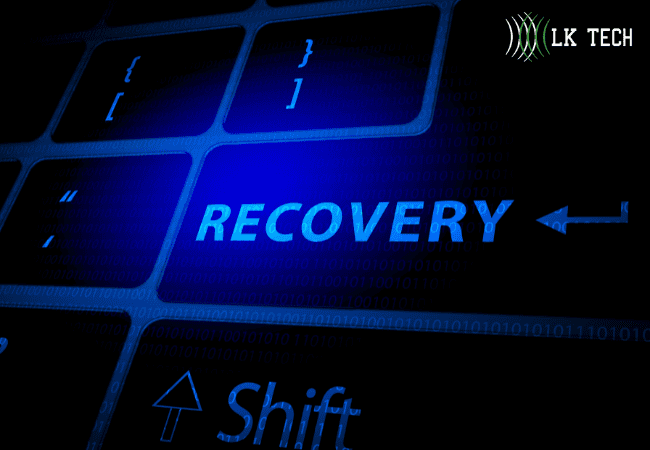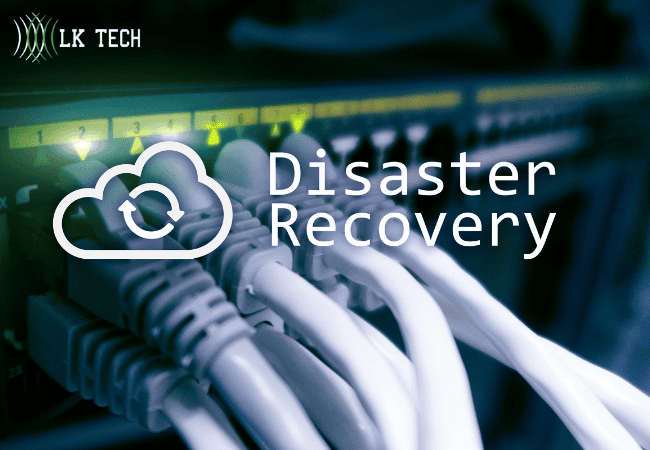In the fast-paced world of technology, disasters can strike at any time, causing disruptions and potentially significant damage to a small business. That's where disaster recovery comes into play. This article will provide an understanding of what disaster recovery is and highlight its importance for small businesses. An IT Service Provider ensures that businesses can recover swiftly from any IT-related disaster, safeguarding their operations and minimizing downtime.
What is Disaster Recovery?
Disaster recovery refers to the process and strategies put in place to mitigate the impact of unexpected events or disasters on a business's IT infrastructure and operations. It involves planning, implementing, and managing measures to recover critical systems, data, and applications in the event of a disruption.
Disasters can come in various forms, such as natural disasters like hurricanes, floods, or earthquakes, as well as human-made disasters like cyberattacks, hardware failures, or power outages. Regardless of the cause, the goal of disaster recovery is to minimize downtime, restore operations, and ensure business continuity.

Importance of Disaster Recovery for Small Businesses
For small businesses, the impact of a disaster can be particularly devastating. Without a proper disaster recovery plan in place, small businesses may face prolonged downtime, loss of critical data, financial loss, damage to their reputation, and even the risk of closure.
Having a well-designed disaster recovery plan is crucial for small businesses for several reasons:
- Minimizing Downtime: A disaster recovery plan ensures that small businesses can quickly recover and resume their operations following a disruptive event. This minimizes downtime and helps maintain productivity, customer satisfaction, and revenue generation.
- Protecting Data and Assets: Small businesses often rely on their digital infrastructure to store and manage critical data. Disaster recovery solutions, such as regular backups and data recovery mechanisms, safeguard valuable information and prevent data loss.
- Ensuring Business Continuity: By implementing disaster recovery measures, small businesses can ensure the continuity of their operations, even in the face of unexpected events. This allows them to maintain customer trust, meet contractual obligations, and continue serving their clients.
- Mitigating Financial Loss: The financial impact of a disaster can be severe for small businesses. Disaster recovery planning helps minimize financial losses by reducing downtime, preventing data loss, and facilitating a quicker recovery process.
- Protecting Reputation: Small businesses rely heavily on their reputation and customer trust. A well-executed disaster recovery plan demonstrates preparedness and resilience, helping to protect the business's reputation and maintain customer confidence.
Understanding the fundamentals of disaster recovery is the first step toward safeguarding your small business against potential disruptions. Recognizing the importance of disaster recovery and implementing the right strategies can better prepare small businesses to navigate the challenges that arise from unexpected events.
Components of Disaster Recovery
Disaster recovery is a comprehensive process that involves several key components to ensure the effective restoration of business operations in the event of a disaster. These components include risk assessment and planning, backup and data recovery, and system redundancy and failover.
Risk Assessment and Planning
Risk assessment and planning are fundamental steps in disaster recovery. This involves identifying potential risks and vulnerabilities that could impact the business, such as natural disasters, power outages, or cyber attacks. By conducting a thorough risk assessment, businesses can gain insights into their critical assets, dependencies, and potential points of failure.
Once risks are identified, businesses can develop a disaster recovery plan that outlines the necessary strategies and actions to mitigate and respond to those risks. This plan should include protocols for communication, evacuation procedures, and the allocation of responsibilities during a disaster. Regular reviews and updates to the plan are essential to ensure its effectiveness and alignment with the evolving needs of the business.
Backup and Data Recovery
Another crucial component of disaster recovery is backup and data recovery. In the event of a disaster, data loss can be detrimental to a business. Implementing a robust backup and data recovery strategy helps safeguard the company's essential information and allows for its swift restoration.
Businesses should regularly backup their critical data and store it securely, either on-site or off-site. The frequency of backups should be determined by the importance and volatility of the data. By maintaining up-to-date backups, businesses can minimize the impact of data loss and facilitate efficient recovery.
System Redundancy and Failover
System redundancy and failover are crucial components of disaster recovery that ensure the availability and continuity of business operations. Redundancy involves creating duplicate systems or components to serve as backups in case of failure. This redundancy can include redundant servers, network infrastructure, or power supply systems. By having redundant systems in place, businesses can minimize downtime and maintain critical operations even if one system fails.
Failover is the process of automatically switching to redundant systems when a failure is detected. This seamless transition allows for uninterrupted operations and minimizes the impact of a disaster. Failover systems can be implemented for various components, such as servers, networks, or databases.
By incorporating system redundancy and failover mechanisms into their disaster recovery plans, businesses can enhance their resilience and minimize the impact of disruptions. Understanding and implementing these components of disaster recovery is crucial for small businesses to effectively respond to and recover from unforeseen events. Conducting risk assessments, implementing backup strategies, and incorporating system redundancy can enhance preparedness and minimize the potential impact of disasters.
How Disaster Recovery Works
Disaster recovery is a critical process that enables businesses to bounce back from disruptive events and ensure the continuity of their operations. Understanding how disaster recovery works is essential for small businesses to effectively plan and implement strategies to minimize downtime and data loss. This section will outline the key steps involved in disaster recovery: detection of disruption, response and recovery process, and testing and maintenance.
Detection of Disruption
The first step in disaster recovery is the detection of a disruption. This can be triggered by various events such as natural disasters, power outages, hardware failures, or cyber-attacks. Monitoring systems, alarms, and network monitoring tools play a crucial role in detecting any abnormal activities or incidents that may impact the business's IT infrastructure.
Timely detection of disruptions is vital as it allows businesses to initiate their response and recovery processes promptly. Quick identification of the problem helps to minimize the impact on operations and mitigate potential financial and reputational losses.
Response and Recovery Process
Once a disruption is detected, the response and recovery process begins. This involves activating the pre-defined disaster recovery plan, which outlines the necessary steps and procedures to follow in order to restore operations and recover data.
The response phase focuses on immediate actions to address the disruption and mitigate its impact. This may involve activating backup systems, diverting traffic to secondary servers, or implementing failover mechanisms. The goal is to restore essential services and minimize downtime as much as possible.
The recovery phase involves restoring the affected systems, applications, and data to their normal state. This may include restoring from backups, rebuilding servers, or recovering data from off-site storage. The recovery process should be conducted in a systematic and controlled manner, ensuring that all critical components are restored and tested for functionality.
Testing and Maintenance
Regular testing and maintenance are essential for the effectiveness of disaster recovery plans. Testing allows businesses to identify any weaknesses or gaps in their recovery processes and make necessary improvements. It ensures that the plan is up to date, and all stakeholders are familiar with their roles and responsibilities.
Testing can be done through various methods such as tabletop exercises, simulated scenarios, or full-scale drills. Simulating different disaster scenarios allows businesses to assess the efficiency of their recovery procedures, identify areas for improvement, and refine their plans accordingly.
Maintenance involves periodic reviews and updates to the disaster recovery plan. As technology evolves and business requirements change, it is crucial to keep the plan aligned with current needs and best practices. Regular maintenance helps to ensure that the plan remains relevant and effective in addressing potential disruptions.
Following these steps of detection, response and recovery, and testing and maintenance, small businesses can establish a robust disaster recovery framework. This allows them to protect their critical systems and data, minimize downtime, and ensure business continuity even in the face of unexpected disruptions.

Types of Disaster Recovery Solutions
When it comes to implementing a disaster recovery plan, small businesses have several options to consider. The choice of a disaster recovery solution depends on factors such as budget, scalability, and the specific needs of the business. In this section, let’s explore three common types of disaster recovery solutions: on-site disaster recovery, cloud-based disaster recovery, and hybrid disaster recovery.
On-Site Disaster Recovery
On-site disaster recovery involves the implementation of a recovery solution within the premises of the business. This typically includes the setup of a secondary data center or backup infrastructure located at a separate physical location within the same organization. The primary advantage of an on-site disaster recovery solution is the direct control and accessibility it provides over the recovery process.
Small businesses opting for on-site disaster recovery can establish dedicated servers, storage systems, and network equipment to replicate critical data and applications. This approach allows for faster recovery times and increased flexibility in customizing the recovery environment. However, it is important to note that on-site solutions may require additional investment in infrastructure, maintenance, and regular testing to ensure their effectiveness.
Cloud-Based Disaster Recovery
Cloud-based disaster recovery has gained popularity among small businesses due to its cost-effectiveness and scalability. This solution involves replicating critical data and applications to a remote cloud environment provided by a third-party service provider. By leveraging the cloud, businesses can benefit from the provider's infrastructure, which often includes redundant data centers and advanced security measures.
With cloud-based disaster recovery, businesses can access their replicated data and applications from anywhere with an internet connection. This flexibility allows for rapid recovery and minimal downtime during a disaster. Additionally, cloud-based solutions often offer automated backup and recovery processes, reducing the burden on internal IT resources.
When considering cloud-based disaster recovery, it is essential to assess the provider's reliability, security measures, and service level agreements (SLAs). Businesses should also consider any regulatory or compliance requirements that may impact the choice of a cloud service provider.
Hybrid Disaster Recovery
Hybrid disaster recovery combines elements of both on-site and cloud-based solutions to create a robust and flexible recovery strategy. This approach allows businesses to leverage the benefits of both options while addressing specific needs and requirements. In a hybrid disaster recovery setup, businesses can choose to replicate critical data and applications both on-site and in the cloud.
Adopting a hybrid approach allows businesses to customize their disaster recovery strategy based on the sensitivity and criticality of different data and applications. For example, businesses may choose to store less critical data on-site while replicating mission-critical information in the cloud. This flexibility provides an optimal balance of control, cost-effectiveness, and scalability.
When implementing a hybrid disaster recovery solution, it is crucial to establish seamless integration and synchronization between the on-site and cloud environments. Regular testing and maintenance are also necessary to ensure that the recovery processes are reliable and up-to-date.
Choosing the right disaster recovery solution for a small business requires careful consideration of various factors, including budget, scalability, and specific business needs. By assessing these factors and exploring the different types of solutions available, businesses can implement a disaster recovery plan that provides reliable protection and minimizes the impact of potential disasters.

Choosing the Right Disaster Recovery Plan
When it comes to choosing a disaster recovery plan for your small business, there are several factors to consider. Assessing your business needs, budget considerations, scalability, and flexibility are key elements in making the right decision.
Assessing Business Needs
Before selecting a disaster recovery plan, it's crucial to assess your business needs thoroughly. Consider factors such as the criticality of your data and applications, the potential impact of downtime on your operations, and the recovery time objectives (RTOs) and recovery point objectives (RPOs) that align with your business requirements.
Understanding your specific needs helps determine the level of protection and recovery capabilities required. This assessment guides you in choosing a disaster recovery solution that meets your business goals and provides the necessary level of resilience.
Budget Considerations
Budget is an essential consideration for small businesses when implementing a disaster recovery plan. It's important to evaluate the costs associated with different solutions and weigh them against the potential risks and impact of downtime on your business.
Consider the initial investment required for hardware, software, and infrastructure, as well as ongoing costs such as maintenance, monitoring, and licensing fees. Compare the costs of on-site disaster recovery solutions with cloud-based or hybrid options. Remember to factor in the costs of data backup and storage, data transfer, and any additional services required.
While it may be tempting to opt for the cheapest solution, it's important to strike a balance between cost and the level of protection and recovery capabilities provided. Investing in a robust disaster recovery plan is essential to safeguard your business against potential disruptions.
Scalability and Flexibility
Scalability and flexibility are critical factors to consider when choosing a disaster recovery plan. As your business grows, your IT infrastructure and requirements may change. It's crucial to select a solution that can scale with your business and adapt to evolving needs.
Consider the ability to add or remove resources as needed, such as storage capacity or computing power. Evaluate the flexibility of the solution in terms of supporting different types of applications and data, including virtualized environments or specific industry software.
Additionally, consider the ease of integrating the disaster recovery plan with your existing IT infrastructure. Seamless integration and compatibility with your current systems will ensure a smooth transition and minimize disruptions during implementation.
By assessing your business needs, considering your budget, and evaluating scalability and flexibility, you can make an informed decision when choosing the right disaster recovery plan for your small business. Remember to regularly review and update your plan as your business evolves and new technologies emerge.

Implementing Disaster Recovery
Once a disaster recovery plan has been developed, it is essential to effectively implement and maintain it to ensure its effectiveness in times of crisis. This section explores three key aspects of implementing disaster recovery: training and preparedness, monitoring and updates, and continuous improvement and evaluation.
Training and Preparedness
Proper training and preparedness are vital to ensure that all employees are well-equipped to handle a disaster situation. Training programs should be designed to educate employees on their roles and responsibilities during a crisis, as well as the specific steps to be taken to initiate the disaster recovery plan.
Some key training elements to consider include:
- Conducting regular training sessions to familiarize employees with the disaster recovery plan and their respective roles.
- Providing training on the use of backup systems, communication protocols, and any specialized tools or equipment required during the recovery process.
- Simulating disaster scenarios through drills and exercises to test the effectiveness of the plan and identify areas for improvement.
- Documenting and disseminating the disaster recovery plan to ensure that all employees have access to the necessary information.
Investing in training and preparedness enhances a business's ability to respond effectively to a disaster and minimizes the impact on operations.
Monitoring and Updates
Disaster recovery plans should not be static documents. Regular monitoring and updates are essential to ensure that the plan remains relevant and aligned with the evolving needs of the business. This involves:
- Conducting periodic risk assessments to identify new potential threats and vulnerabilities.
- Reviewing and updating the plan to address any changes in the business environment, such as new systems, processes, or locations.
- Regularly testing the backup and recovery systems to verify their functionality and effectiveness.
- Monitoring the performance of the disaster recovery plan and making adjustments as necessary.
Actively monitoring and updating the plan allows businesses to stay ahead of potential risks and ensure their disaster recovery capabilities remain robust and up to date.
Continuous Improvement and Evaluation
Disaster recovery is an ongoing process that requires continuous improvement and evaluation. This involves regularly assessing the effectiveness of the plan and identifying areas for improvement. Key steps in this process include:
- Conducting post-disaster reviews to evaluate the response and recovery efforts.
- Gathering feedback from employees and stakeholders to identify any shortcomings or areas for improvement.
- Analyzing any lessons learned from previous incidents and incorporating them into the plan.
- Regularly reviewing industry best practices and emerging technologies to enhance the disaster recovery capabilities.
Continuously evaluating and improving the disaster recovery plan enables businesses to adapt to changing circumstances and ensure their recovery measures remain effective and efficient.
Implementing a well-designed disaster recovery plan is crucial for small businesses to protect their operations and minimize downtime during a crisis. By focusing on training and preparedness, monitoring and updates, and continuous improvement and evaluation, businesses can enhance their disaster recovery capabilities and improve their ability to bounce back from any potential disruption.

Secure Your Business with Reliable Disaster Recovery Solutions in Cincinnati
At LK Tech, we understand the critical importance of safeguarding your business against unforeseen disruptions. Our tailored disaster recovery solutions in Cincinnati ensure that your data, operations, and customer trust remain intact, even in the face of emergencies.
With expert planning, cutting-edge technology, and a commitment to rapid response, LK Tech delivers peace of mind so you can focus on what matters most—your business's success. Contact us today to secure your business with our trusted disaster recovery services.


